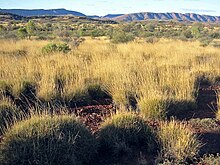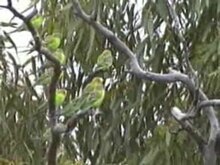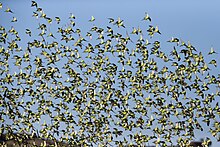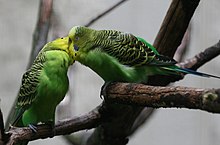Budgie
| Budgie | ||||||||||||
|---|---|---|---|---|---|---|---|---|---|---|---|---|

Budgerigar ( Melopsittacus undulatus ), female in natural habitat in Australia |
||||||||||||
| Systematics | ||||||||||||
|
||||||||||||
| Scientific name of the genus | ||||||||||||
| Melopsittacus | ||||||||||||
| Gould , 1840 | ||||||||||||
| Scientific name of the species | ||||||||||||
| Melopsittacus undulatus | ||||||||||||
| ( Shaw , 1805) |
The budgerigar ( Melopsittacus undulatus ) is a bird art that the family of authentics Parrots belongs (Psittacidae). They are small birds with a narrow, strongly stepped tail. The sexes are colored the same, juvenile birds resemble adult birds. Budgies are the most common parrot species in Australia , but the frequency varies from region to region due to the inconsistent climatic conditions. Because of the increasing pasture economy, as a result of which numerous cattle troughs were set up, their chances of survival improved in many of the arid regions of Australia. This has partly led to a significant increase in the number of individuals.
In their natural range, budgies live in sometimes very large flocks . They stand out for their flight noise and their trilling contact calls. Budgerigars are resident birds in climatically favorable regions . In arid climates they move on when the water points dry up.
Budgies have been kept as pet birds in Europe since 1840 . As early as the second half of the 19th century, the bird was bred in large numbers to meet the demand for this species. Today the budgie is probably the most frequently kept parrot species worldwide. There are numerous cultivated forms that differ in size, color and plumage characteristics from the wild form .
features
Wild-type budgies are around 18 cm long and have no noticeable sexual dimorphism . Females are slightly heavier and weigh between 24 and 40 grams, while wild males weigh between 22 and 32 grams. The sexes can mainly be distinguished by the color of the wax skin , which is blue in the wild form in the males and brown in the females.
Budgerigars have a bright green basic color, which is overlaid by black transverse bands, the eponymous waves. The banding begins at the front of the head. The wave pattern is very fine on the head and front back and merges into broad horizontal stripes on the wing covers. The forehead, the eye region, the throat and the front half of the cheek are yellow. They each have a bruise on their cheeks, and four to six black, rounded spots above the throat. In the case of mutation forms, the number of throat patches can differ.
The under wing-coverts are green, the tail greenish-blue and the outer feathers shorter in the middle with a yellow band. The feet are grayish blue. Under ultraviolet radiation , some feathers of the head plumage fluoresce in the wild form, but not in the blue and white cultivated forms, sulfur yellow. Budgies are tetrachromatic and UV-sighted.
Young birds are generally a little more dull in color than the adult birds. The wave drawing begins with them on the forehead and forehead. The black spots on the throat are blurred or even absent. They differ from the adult budgerigars in that their wax skin has a pinkish-violet color, dark eye skin and iris .
distribution

The budgie is part of the fauna of Australia and its natural distribution is restricted to the Australian continent . It inhabits almost all of mainland Australia and is only absent in the extreme southwest, on the Cape York Peninsula, which is lined with tropical rainforest, and in most of the coastal regions of northern and eastern Australia. There have been sightings of budgies in Tasmania . However, these are refugees from prison .
In regions where water and food are available all year round, the budgie is a resident bird . This is the case, for example, in northern eastern Australia. However, the infrequent rainfall and the dependence of budgies on seeds from ground cover plants such as grass force the budgies to be nomadic in most Australian regions. To what extent the budgerigar migrations are subject to a seasonal north-south direction or whether they are only opportunistically nomadic is still a matter of dispute. There is evidence to suggest that older and therefore more experienced budgies seek out traditional feeding grounds on these migrations. Inexperienced parakeets either follow them or wander around in search of suitable food. Migrating budgies only cover relatively short distances on their migrations. They are not able to build up larger fat deposits in the open air, so that they cannot fly for long periods of time. Budgies fly a maximum of three hours without a break and can cover about 100 kilometers in this time.
Overgrown stocks in Kuwait and Florida no longer exist.
habitat
Budgies colonize a variety of arid and semi-arid habitats: with spiked head grasses covered sand dunes, plains with scattered trees and Log - or Maireanabewuchs , acacia scrubland , mallee shrub land Baumsavanne residues and forest islands in farmland. On the other hand, they avoid forest areas. Preferred tree species are the eucalyptus ( Eucalyptus microthera and Eucalyptus camaldulensis ) that are widespread along seasonal waterways . Budgies also inhabit golf courses. Although they were able to survive in experiments without additional watering, they prefer habitats near watercourses and water points. Budgies also benefit from the creation of water points for the breeding of cattle and sheep.
food

Budgies are extreme food specialists that feed primarily on the seeds of ground cover plants. In studies, the seeds of 21 to 39 ground-covering plant species were found, but no seeds from higher-growing plants. The length of the seeds was between 0.5 and 2.5 mm and the weight per seed was 0.36–1.33 mg. The majority of the seeds were ripe and were swallowed de-husked. The recurring claim that immature seeds are needed to raise young ones could not be substantiated. The beak morphology is adapted to eating seeds and is a special development within the close relatives of the budgies.
The habitat in arid Central Australia shows changing environmental conditions, especially with the precipitation, which often occurs only regionally or does not occur over several years. The food supply is therefore not related to the seasons, at least in the interior of the country. The migratory movement of the budgie follows the food supply. Remarks on the migratory movement of budgerigars can already be found in the early publications on budgerigars, for example by Gould 1840. Budgerigars need seeds for food and especially for rearing young, which are only sufficiently available in rainy vegetation periods.
Behavior and reproduction
Budgerigars live at least temporarily in large flocks and are extremely opportunistic breeders, which, regardless of the season, breed whenever and as long as favorable conditions prevail. In male budgerigars, there is no evidence of reactions of the gonads to seasonal differences in the photoperiod , which regulate the time of breeding in most birds at higher latitudes and which can often also be detected in equatorial bird species without significant changes in the photoperiod. Even experimental short- and long-term days (17: 7 hours), which are much more extreme than in the natural range of the parakeets, did not lead to an inhibition or activation of the gonads and had no effect on the time of onset of sexual maturity. Adult males have permanently active gonads, at least under laboratory conditions.
The early sexual maturity of the budgerigars, especially the males, is said to be another mechanism that enables them to adapt quickly to breeding conditions and thus promote breeding success. However, data that were collected in New South Wales between 1972 and 1974 hardly support this hypothesis, but there is evidence of a clear correlation between food supply and breeding success. Food must then be in abundance for at least three months.
Based on the broods examined, there seems to be a tendency for different breeding seasons to exist depending on the region. Birds in the south seem to breed in the spring and summer months between August and February, whereas northern waveband parakeets appear to breed at the beginning of the dry season in autumn and winter. The parakeets can start breeding at any time under suitable conditions, such as abundant rainfall.
The budgerigars, which live in swarms in pairs, are, like almost all parrot birds, cave-breeders who use tree hollows. You are sexually active year round. The birds show intense social behavior with partner cleaning and partner feeding.
The female demonstrates her willingness to mate with a boat-shaped posture reminiscent of the submissiveness of young animals. It crouches rigidly on a branch, leans its head back, lowers and spreads its wings, and lifts its tail. The male climbs on the female first with one foot and then with both feet, the heads pointing in the same direction. The two buttocks approach each other until the two cloaca can be pressed together.
A clutch usually consists of four to six eggs, in exceptional cases eight eggs. The eggs are incubated by the female from the first egg. After around 18 days the young hatch and the male provides the female with food pulp. The actual hatching process takes 20 minutes. Female budgies help the very helpless chicks hatch. Newly hatched chicks weigh around 2 g. The young fly out after 30–35 days.
In budgerigars, eleven different vocalizations are recorded, of which a trilling contact call is the most familiar to us. Other calls serve to coordinate formation flights, as alarm calls , as intraspecific threatening gestures or belong to courtship . Budgies can hear frequencies between 40 and 14000 Hz.
Puberty, life expectancy

The first mature sperm cells appear in male budgies between 3 ½ and 4 months of age. At the age of 50 days, first contacts with other budgies are sought, at 70 days preferences for later partnerships become apparent, at 105 days the pairing is completed. Whether budgies are mated to the same bird for life is controversial.
According to older literature, the maximum age of budgies in captivity should be between 15 and 17 years. However, this age is currently rarely reached, a realistic range of values is between five and ten years, so far there is no field data.
Budgies are among the prey of some birds of prey ; in Australia they are hunted by hawks , sparrows and falcons . In Central Europe, captive refugees are victims of tree falcons (in a Berlin study they made up 9% of prey birds), peregrine falcons and hawks.
Danger
The IUCN ( International Union for Conservation of Nature ; German "International Union for the Preservation of Nature") classifies the budgies as harmless ( least concern ).
Systematics
George Shaw first mentioned the bird in 1794 in the book Zoology of New Holland . He received the specimens used for this from one of the early settlers who had collected them in the Parramatta area . In 1805 Shaw first described the budgie scientifically in The Naturalist's Miscellany . It also contains the oldest scientific illustration of the kind by Frederick Polydore Nodder , based on the bellows of the British Museum . At the beginning, bellows material from budgerigars was rare, in 1832 only two bellows were known in Europe. The genus name that is valid today was introduced by John Gould in 1840 in Volume V of his work The Birds of Australia , where he also writes about his field observations. Since then the budgie has been named Melopsittacus undulatus (Shaw 1805). The name is derived from Gr. Mélos "song, lament", psittacus "parrot or parakeet" and Latin undulatus "wavy".
The budgie is the only representative of its genus and has no subspecies. Biochemical studies have shown a close relationship to the grass parakeets ( Neophema ). The structure of the carotid arteries of both genera is based on the same basic type.
attitude
Start of keeping in Europe

In 1840 it was presumably John Gould who first introduced living specimens to England and thus to Europe . Since then, budgerigars have been transported on every ship that sailed from Australia to Europe. Saulnier achieved the world's first breeding in France in 1846, the Antwerp zoo was successful in 1850, and in 1855 a private owner succeeded in first breeding in Germany. In the USA, the first breeding is not documented until 1909. A bird exhibition in Antwerp in 1850 made the bird known throughout Europe. Shortly afterwards, large numbers of wild-caught animals were imported into Europe. The first husbandry report that can be understood as care instructions comes from Jules Delon , who reported for a meeting of the Societe Imperiale Zoologique d'Acclimation in Paris in 1854 . From around 1846/47 the birds can be found more frequently in the trade. As early as 1859, the bird was commonly known in Germany, at least in large cities, under the name Undulatus parrot. The demand was initially covered by mass imports, which led to a significant drop in prices. For example, a London dealer shipped 14,069 pairs from February 10 to July 27, 1878, and another 79,655 pairs from September 1878 to January 1879. These mass exports did not come to an end until 1894 when the general ban on the export of birds from Australia was still in effect today. Commercially oriented mass breeding already existed in England, France and Germany by 1880, Karl Russ estimated the "annual production" in Germany in 1880 at 50,000 animals. When the First World War broke out and the bird market collapsed as a result, around 120,000 budgies were killed at the French large breeder Bastide because they could no longer be sold.
The mass reproduction produced more and more forms of mutation. In 1878 a Belgian bred the first sky-blue parakeets. It is unclear whether the sky-blue mutation forms shown for the first time by a Belgian at an exhibition in 1910 belong to the descendants of these parakeets, but this color has been consistently documented ever since. The color dark green followed immediately after the First World War, from the dark green parakeets olive green ones were bred. Cobalt-blue, mauve and white-blue cultivated forms are almost the same age. The first gray-winged parakeets were bred in 1927/28. Yellow ("lutino") budgerigars are recorded as an import of a pair from the field from the British breeder J. Abrahams for the year 1886.
At first, the prices for color mutants were not very high; However, after there was a great demand for these animals in Japan , prices exploded before the Second World War to as much as 175–200 pounds per pair, a price level that had hardly been reached by any animal species until then.
Breeders' Associations and Budgies as an Object of Genetics
In 1925 the important The Budgerigar Club was founded in England , which in 1957 had tens of thousands of members worldwide. As the first German special association for budgie breeders, the German Budgie Breeders Association (DWV) was founded in 1926 as a subdivision of the exchange center for bird lovers and breeders in Germany (AZ). In the breeding facility of Carl Hubert Cremer and with the participation of numerous other breeders from the circle of DWV, Hans Julius Duncker was able to explain the applicability of Mendel's rules to budgies and the inheritance of color mutations. This was an important step not only for mutation breeding of budgerigars (and other parrot species in which mutation breeding is practiced), but also in scientific genetics itself. At the same time and independently of Duncker, Hans Steiner worked in Switzerland on the genetics of the mutation forms. In the 1970s, investigations into the ethology of budgerigars followed, which were neglected in classical behavioral research. This late point in time is somewhat surprising, as Carl August Bolle had already written in 1859 about the intensive pairing behavior of parakeets.
The German Standard Budgie Breeders Association (DSV) was founded in 1959 as a special association that deals exclusively with the keeping, breeding and exhibition of budgerigars. He is a founding member of the WBO " World Budgerigar Organization " (World Budgerigar Organization).
The so-called standard budgie is displayed at bird shows today. At 21.6 cm it is significantly larger than the normal breeding budgie, which breeders call Hansi-Bubi . The breeding statistics of the AZ show an average of around 20,000 offspring from several thousand breeding pairs for the years 2002–2008. A rare deviation that occurs in breeding is so-called featherduster .
New imports and offspring of the wild type
A new breed of wild Australian strain has existed in Germany since 2005. These parakeets can be seen, for example, in the Cologne Zoo .
literature
- Tom Aumann: An intraspecific and interspecific comparison of raptor diets in the south-west of the Northern Territory, Australia. In: Wildlife Research. Volume 28, No. 4, 2001, pp. 379-393, doi: 10.1071 / WR99092 .
- Carl Bolle : Beginning domestication of the undulatus parrots (Melopsittacus undulatus Gould). In: Journal of Ornithology. Volume 7, No. 4, July 1859, pp. 299–308, doi: 10.1007 / BF02001121 ( Contains the description of keeping Jules Delon and the description of the German first breeding).
- Curt af Enehjelm : The book of the budgie . Pfungstadt 1957 (edited by Joachim Steinbacher ).
- Werner Lantermann : parrot science. Biology, ecology, species protection, behavior, keeping, species selection of the parakeets and parrots. Paul Parey, Berlin, 1999, ISBN 3-8263-3174-5 .
- Joseph M. Forshaw : Australian Parrots. 1st German-language edition. Volume 2, Arndt-Verlag, Bretten 2003, ISBN 3-9808245-2-7 .
- Hans Steiner: Heredity studies on the budgie. In: Archive of the Julius Klaus Foundation for Heredity Research, Social Anthropology and Racial Hygiene, Zurich. Volume 7, No. 2, 1932, p. 149.
- Gunvor Pohl-Apel, Roland Sossinka: Development of gonads in the budgie , Melopsittacus undulatus under different light conditions. In: Journal of Ornithology. Volume 116, No. 2, April 1975, pp. 207-212, doi: 10.1007 / BF01640956 .
- Gunvor Pohl-Apel: Sexual ontogenesis in male budgies Melopsittacus undulatus. In: Journal of Ornithology. Volume 121, No. 3, July 1980, pp. 271-279, doi: 10.1007 / BF01647617 .
- Anders Ödeen, Olle Håstad: Complex Distribution of Avian Color Vision Systems Revealed by Sequencing the SWS1 Opsin from Total DNA. In: Molecular Biology and Evolution. Volume 20, No. 6, 2003, pp. 855-861, doi: 10.1093 / molbev / msg108 .
- Sophie M. Pearn, Andrew TD Bennett, Innes C. Cuthill: Ultraviolet vision, fluorescence and mate choice in a parrot budgerigar Melopsittacus undulatus. In: Proceedings of the Royal Society London B Biological Sciences. Volume 268, 2001 pp. 2273-2279, doi: 10.1098 / rspb.2001.1813 .
- Otto Völker: About fluorescent, yellow feather pigments in parrots, a new class of feather dyes. In: Journal of Ornithology. Volume 85, No. 1, 1937, pp. 136-146, doi: 10.1007 / BF01905492 .
Individual evidence
- ↑ a b c Forshaw 2003, p. 631
- ↑ Enehjelm 1957, p. 15
- ↑ Robilier 1997, p. 58
- ↑ Völker 1937
- ↑ Pearn, Bennett, Cuthill 2001, pp. 2273-2279; Ödeen, Håstad 2003, pp. 855-861.
- ↑ a b Lantermann 1999, p. 422
- ^ Forshaw, p. 631 and p. 632
- ↑ a b c Forshaw 2003, p. 636
- ↑ Forshaw 2003, p. 637
- ↑ a b Melopsittacus undulatus in the IUCN Red List of Threatened Species .
- ^ Christopher J. Butler: Feral Parrots in the Continental United States and United Kingdom: Past, Present, and Future. In: Journal of Avian Medicine and Surgery. Volume 19, No. 2, 2005, pp. 142-149, here: pp. 143f. (PDF file; 145 kB).
- ↑ Lantermann, p. 422
- ↑ Forshaw 2003, p. 632, p. 634
- ↑ Lantermann 1999, p. 423
- ↑ a b c d Forshaw 2003, p. 638
- ↑ Dominique G. Homberger: Functional-morphological investigations on the radiation of the feeding and drinking methods of the parrots. Dissertation of the Philosophical Faculty II of the University of Zurich, Bonn 1980, ISBN 3-925382-13-5 , p. 80.
- ↑ Pohl-Apel 1980, p. 271
- ↑ Wyndham 1974 after Pohl-Apel / Sossinka 1975 p. 210.
- ↑ a b Pohl-Apel, Sossinka 1975 p. 210.
- ↑ Brockway 1964 after Pohl-Apel 1980, p. 272.
- ↑ a b Forshaw 2003, p. 639
- ^ Dilger 1960 after Lantermann 1999, p. 170
- ↑ Lantermann 1999, p. 170
- ↑ a b Lantermann 1999, p. 424
- ↑ a b Lantermann 1999, p. 177
- ↑ Lantermann 1999, p. 424 f.
- ↑ Audio examples can be found here [1]
- ↑ Lantermann 1999, p. 82
- ↑ Pohl-Apel 1978, p. 274.
- ↑ Lantermann 1999, p. 303
- ↑ Gaby Schulemann-Maier: birds-online - everything about budgies. Bottom: How old do budgies get? [2]
- ↑ Aumann 2001
- ↑ Compilation in: D. Franz: European free-range parrots as prey of birds of prey. In: Parrots. Volume 10, 2006, pp. 386-393.
- ↑ a b c d Enehjelm 1957, p. 23
- ↑ Information on the scientific name: zoonomes
- ↑ Strunden: The Names of Parrots and Parakeets. P. 57 and 75.
- ↑ Enehjelm 1957, p. 22
- ↑ Bolle 1859, p. 302
- ↑ Lantermann 1999, p. 425
- ↑ Jules Delon 1854 after Enehjelm23
- ↑ Bolle 1859, p. 301
- ↑ a b Enehjelm 1957, p. 24
- ↑ Enehjelm22f.
- ↑ a b c Enehjelm 1957, p. 25
- ↑ a b c Enehjelm 1957, p. 26
- ↑ Enehjelm 1957, p. 17
- ↑ Enehjelm 1957, p. 171 f.
- ↑ Enehjelm 1957, p. 117
- ↑ Enehjelm171, example: H. Duncker: About color inheritance in budgerigars (with demonstrations). In: Molecular and General Genetics MGG Volume 50, Number 1 / December 1929, pp. 101-102
- ↑ Lantermann 1999, p. 426
- ↑ About Harddy 1963 and 1965 by Lantermann 1999, pp 117, 426
- ^ Website of the DSV
- ^ WBO website
- ↑ according to AZ (2000) statistics
- ↑ according to AZ (2005) statistics
- ^ Budgie , website VdZ.
Web links
- Melopsittacus undulatus in the endangered Red List species the IUCN 2008. Posted by: BirdLife International, 2008. Accessed January 4 of 2009.
- Videos, photos and sound recordings of Melopsittacus undulatus in the Internet Bird Collection
- Thomas Arndt : Lexicon of Parrots
- Gaby Schulemann-Maier: birds-online - everything about budgies
- Trained budgies
- Feathers of the budgie









